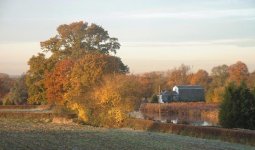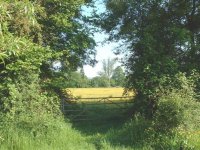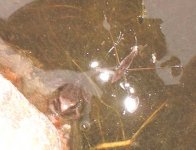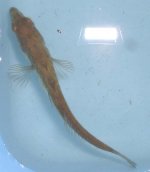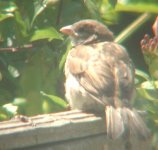My 'local patch' is an ill-defined area around our home in Hurst Green, immediately south of Oxted, in east Surrey. Within a mile there is a good variety of habitats. Our house (since March 1993) overlooks Coltsford Mill Pond (grid ref. TQ 398507), which contains a small island. (The pond is on private land but can be viewed from a public footpath which passes to the south of it.)
To the west of the pond, running south along the zero meridian is the alder-lined River Eden, here a stream. Much of the area around the village is mixed farmland, some of which, particularly to the south-west, has been allowed to 'go native'. There are dense, mature hedgerows and fields which are cut annually allowing attractive wild-flower meadows to develop. (I am no botanist but I have noticed common spotted orchids, bitter vetchling and speedwell, for example.) One field alongside the Eden, which was formerly a flood meadow, is designated as a Site of Nature Conservation Value. Unfortunately the owner keeps mowing it. There is a sewage works nearby.
The area also has mature woodland, notably Foyle Riding and Staffhurst Wood (an SSSI), both of which are outstanding for bluebells in spring. The former has mature oaks as well as extensive areas of coppiced willow, chestnut and other species. (In 1927 it was the setting for a famous cello recital by Beatrice Harrison with nightingales singing in the background. Extracts can be heard on the BTO CD released in aid of the nightingale appeal.) Staffhurst Wood consists mainly of oak and beech with many immature hornbeams. One area is being planted with cherry and hazel in an attempt to attract dormice, nightingales and hawfinches.
To date, I've seen 94 species of birds from the house or garden, with four more heard. (This total does not include a whooper swan and a barnacle goose of suspect origin, nor a tern or two which were probably common.) I suspect that the Eden might act as something of a 'flyway' (migration route) for migrants, as birds seen from our house include ring ouzel, black redstart (two years running in our garden), whinchat, stonechat, wheatear, spotted flycatcher, common sandpiper and the Sterna terns. Two hundred and twenty swallows were perched on overhead wires in the early morning of 8th September, 1997. They may have roosted overnight among the rushes and sedges on the mill pond island. Migrants never seem to linger, possibly because the pond is used by anglers and there are many dog walkers about.
The island on the mill pond was for some years used as a roost by pied wagtails, my best count being 425 in November 1995. Numbers built up each autumn, dropped considerably in winter and then peaked again, at lower levels, in spring. The island also provides a refuge for snipe and the occasional water rail. Snipe are hard to count but up to 40 may be seen after heavy rain when they move onto an adjacent field, called Pond Tail Meadow.
The pond holds small numbers of tufted ducks in winter (maximum to date 24). Other species have included Egyptian geese, pochard, pintail, gadwall, shoveller and, in January 1998, a smew. In summer, house and a few sand martins often feed over the pond and this may account for occasional hobby sightings. Kingfishers are seen from time to time.
The sewage works holds few birds of interest but it is surrounded by trees and bushes. These provide perches for corvids (up to 200 jackdaws and 125 crows) and harbour the occasional wintering chiffchaff. A few willow warblers (passage migrants only in my area), blackcaps or lesser whitethroats appear and in March 1998 a firecrest arrived with a small influx of goldcrests. The nearby Tandridge District commercial services yard held a black redstart in mid-October, 1996, making it the third in the village in successive years.
As you walk past the sewage works westwards and cross the Eden, you enter good habitat for some declining farm-land species. Bullfinches, yellowhammers and linnets seem to have healthy populations, and skylarks and lapwings maintain a presence. I have seen grey partridges only once. The area is particularly good for turtle doves, with about six males singing in most summers. Nightingales have twice summered. Garden warblers, chiffchaffs, whitethroats, and lesser whitethroats are usually the commonest warblers. It was while looking for the last species in 1997 that I heard a bird giving what sounded like the typical song with a slight change of tempo in the middle. When I finally got a brief view of it, it looked like a common whitethroat though, to my eyes, slightly 'washed out'. It stayed for three or four days and later it was alternating the 'lesser' song with that of the common whitethroat. Another observer was convinced it was indeed a whitethroat but I have never felt sure. It was unusually skulking for a whitethroat and, the habitat seemed more typical of lesser's. Could it have been a hybrid?
In 1996 a male Cetti's warbler summered along the banks of the Eden. Night after night, I could hear it clearly in the small hours from our bathroom window - possibly the only perk of being woken regularly by a toddler! I was interested to observe that the song gradually became shorter as the year progressed until, by mid-June, it often gave just one penetrating note. The fact that it kept singing so persistently may mean that it failed to attract a mate. (For more on insomniac Cetti's warblers, see British Birds Vol 72, p 184.)
The woodland holds the expected species including lesser spotted woodpecker. But either I'm bad at finding them or the LSW is scarce. Marsh tits, on the other hand, can often be found without difficulty, especially in winter and spring.
Nightingales used to occur but I’ve not heard one since 2001.
A recent development has been the digging of a fishpond, called Edenbrook Farm Fishery. It is about an acre in extent with a couple of islands. This has begun to pay dividends with sightings of mandarins, great crested and little grebes, as well as breeding tufted ducks, mute swans, Canada and greylag geese. Kingfishers are regular, and passage birds have included the occasional common sandpiper.
The area is generally good for little owls with several pairs breeding in most years.
I have seen Red-legged Partridge several times, and up to 200 lapwings occur in the autumn months. Last autumn there were also four golden plovers present.
I try and keep a record of what birds are breeding. The most notable phenomenon this year (2003) has been the dramatic rise in lesser whitethroat numbers (about 10 territories) and a corresponding fall in whitethroat territories. Presumably this is because the hedges have matured to the point where they favour the former species.
There is a more about the area on my web site. See below.




